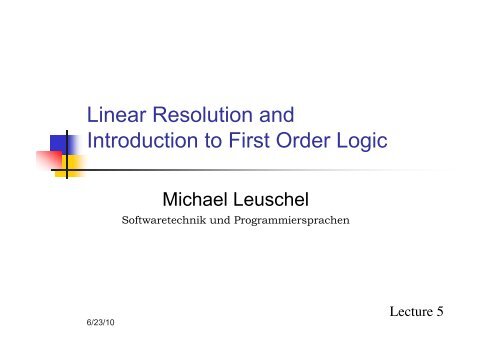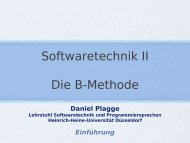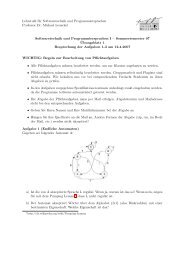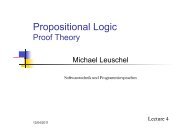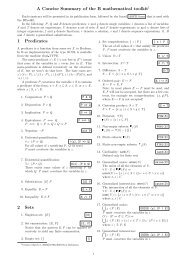Linear Resolution and Introduction to First Order Logic
Linear Resolution and Introduction to First Order Logic
Linear Resolution and Introduction to First Order Logic
You also want an ePaper? Increase the reach of your titles
YUMPU automatically turns print PDFs into web optimized ePapers that Google loves.
<strong>Linear</strong> <strong>Resolution</strong> <strong>and</strong><br />
<strong>Introduction</strong> <strong>to</strong> <strong>First</strong> <strong>Order</strong> <strong>Logic</strong><br />
Michael Leuschel<br />
Softwaretechnik und Programmiersprachen<br />
6/23/10<br />
Lecture 5
Recap: CNF & <strong>Resolution</strong><br />
<br />
<br />
<br />
Conjunctive Normal Form: set of clauses<br />
clause = disjunction of literals<br />
literal = p or ¬p<br />
Example: { ¬p ∨ q , wet ∨ ¬rains ∨ ¬outside }<br />
<strong>Resolution</strong><br />
<br />
From p ∨ α <strong>and</strong> ¬p ∨ β derive a new logical<br />
consequence α ∨ β<br />
Proof by refutation for S ⇒ {L}:<br />
<br />
Show that S ∪ {¬L} is inconsistent by obtaining<br />
the contradiction by resolution<br />
6/23/10
<strong>Resolution</strong>: Further Example<br />
1.) i ∨ l ∨ ¬s ∨ i ∨ k<br />
2.) e ∨ l ∨ ¬r ∨ o ∨ g<br />
3.) r ∨ i ∨ k ∨ s<br />
4 = 2+3.) e ∨ l ∨ o ∨ g ∨ i ∨ k ∨ s<br />
5 = 1+4.) i ∨ l ∨ i ∨ k ∨ e ∨ l ∨ o ∨ g ∨ i ∨ k<br />
i ∨ l ∨ i ∨ k ∨ e ∨ l ∨ o ∨ g ∨ i ∨ k<br />
6/23/10
<strong>Linear</strong> <strong>Resolution</strong><br />
T:<br />
p ∨¬q<br />
q<br />
D: ¬p<br />
D’: ¬q<br />
<br />
<br />
<br />
<br />
<br />
1.Take a theory T in CNF with Horn clauses, but<br />
no denials<br />
2. Take a denial D<br />
3. Resolve the denial with one clause from T<br />
you obtain a new denial D’<br />
4. Set D := D’ (forget old denial) <strong>and</strong> restart at step<br />
2 until you reach a contradiction<br />
Observations:<br />
<br />
Negative literals: always from D, Positive literals always<br />
from T, T remains unchanged<br />
6/23/10
<strong>Linear</strong> <strong>Resolution</strong> <strong>and</strong> Prolog<br />
umbrella ← rain ∧ outside<br />
umbrella :-<br />
rain, outside.<br />
rain.<br />
outside.<br />
umbrella ∨ ¬ rain ∨ ¬<br />
outside<br />
rain<br />
outside<br />
<strong>Linear</strong> =<br />
One can forget the past<br />
?- umbrella.<br />
yes<br />
6/23/10<br />
¬ umbrella<br />
⇓<br />
¬ rain ∨ ¬outside<br />
⇓<br />
¬outside<br />
⇓
Non <strong>Linear</strong> <strong>Resolution</strong><br />
1) cut ∨ ¬ say<br />
2) cut ∨ say<br />
Non-linear resolution required<br />
<strong>to</strong> show that “cut” is a logical<br />
consequence!<br />
One day Tokusan <strong>to</strong>ld his student Gantõ,<br />
“I have two monks who have been here for many years.<br />
Go <strong>and</strong> examine them.”<br />
Gantõ picked up an ax, saying,<br />
“If you say a word I will cut off your heads;<br />
<strong>and</strong> if you do not say a word, I will also cut off your<br />
heads.”<br />
<strong>Linear</strong> =<br />
One can forget the past<br />
Observe: 2) not a Horn clause<br />
6/23/10
6/23/10<br />
<strong>First</strong>-<strong>Order</strong> <strong>Logic</strong>
Why a more expressive logic?<br />
<br />
<br />
<br />
Example:<br />
<br />
<br />
<br />
John loves all girls<br />
Janet is a girl<br />
Therefore, John loves Janet<br />
Propositional <strong>Logic</strong>:<br />
<br />
<br />
{j_loves_all_girls, janet_is_girl} ⇒ {j_loves_janet}<br />
But: argument above still valid<br />
<br />
→ We have <strong>to</strong> be able <strong>to</strong> talk about<br />
objects/individuals<br />
6/23/10
Addition 1: Constants<br />
Constants: a,b,c, john, janet<br />
Start with lowercase letter<br />
Do not st<strong>and</strong> for a truth-value (true/false)<br />
Represent a particular object from the “real<br />
world”<br />
(mathematically: interpretations will map each<br />
constant <strong>to</strong> an element from a domain)<br />
6/23/10<br />
a<br />
b<br />
janet<br />
john<br />
c
Addition 2: Predicates<br />
Predicates: girl(_), loves(_,_), …<br />
Start with lowercase letter<br />
binary<br />
relation<br />
Represent relations between objects<br />
Have an arity<br />
loves(_,_): 2<br />
girl(_): 1<br />
rains: 0<br />
loves(john,janet)<br />
(propositions are just a special case)<br />
6/23/10
Addition 3: Variables<br />
Variables: X,Y,Z,…<br />
Start with uppercase letter<br />
Do not have a truth-value either<br />
Can st<strong>and</strong> for “any” object from the “real<br />
world”<br />
X<br />
6/23/10
Addition 4: Quantifiers<br />
<br />
<br />
Universal quantifier ∀ (for all)<br />
<br />
<br />
<br />
Example: ∀X loves(X,X)<br />
Intuitively: “Everybody loves himself”<br />
(∀X F): means that for all possible values of X<br />
the formula F has <strong>to</strong> be true<br />
Existential quantifier ∃ (there exists)<br />
<br />
<br />
<br />
Example: ∃ X girl(X)<br />
Intuitively: “There exists a girl”<br />
(∃ X F): means that we can find one value (at<br />
least) for X such that the formula F is true<br />
6/23/10
Exercise: Dylan<br />
<br />
Translate in<strong>to</strong> logic:<br />
<br />
<br />
<br />
You can fool some of the people all of the time.<br />
You can fool all of the people some of the time.<br />
But you cannot fool all of the people all of the<br />
time.<br />
<br />
Use predicate:<br />
<br />
fool(X,T): you can fool X at time T<br />
6/23/10
Exercise: Solution<br />
<br />
Translate in<strong>to</strong> logic:<br />
<br />
<br />
<br />
You can fool some of the people all of the time.<br />
You can fool all of the people some of the time.<br />
But you cannot fool all of the people all of the<br />
time.<br />
<br />
A Solution:<br />
∃ X ∀ T fool(X, T)<br />
∀ X ∃ T fool(X, T) (also acceptable: ∃ T ∀ X fool(X, T))<br />
¬ (∀ X ∀ T fool(X, T) )<br />
6/23/10
Addition 5:<br />
Function Symbols<br />
<br />
Function symbols:<br />
succ(_), cons(_,_), …<br />
<br />
<br />
<br />
Start with lowercase letter<br />
Represent <strong>to</strong>tal functions between objects<br />
Have an arity<br />
cons(_,_): 2<br />
succ(_): 1<br />
<br />
john: 0 (constants are just a special case)<br />
unary<br />
function<br />
6/23/10
Natural Numbers<br />
Constant 0<br />
Function symbol succ(_)<br />
Describing natural numbers:<br />
<br />
0<br />
1<br />
succ 2<br />
3<br />
nat(0)<br />
4<br />
∀X ( nat(succ(X)) ← nat(X) )<br />
5<br />
6<br />
7<br />
8<br />
∀X Y Z ( plus(succ(X),Y,succ(Z)) ← plus(X, Y, Z) )<br />
Describing addition:<br />
∀X plus(0, X, X)<br />
9<br />
10<br />
...<br />
6/23/10<br />
(but there are Prolog built-in’s)
Representing Lists<br />
Constant nil: empty list<br />
Function symbol .(_,_)<br />
<br />
∀X app([],X,X)<br />
.(H,T): list with first element H <strong>and</strong> tail T<br />
[a,b] denoted by<br />
.(a,.(b,nil))<br />
[a,b]<br />
[a,a]<br />
[b,a]<br />
.<br />
nil []<br />
[a]<br />
[b]<br />
[b,b]<br />
6/23/10<br />
a<br />
b
Summary<br />
1. <strong>First</strong>-<strong>Order</strong> <strong>Logic</strong><br />
- constants, functions, variables<br />
(<strong>to</strong>m mother(<strong>to</strong>m) X)<br />
- relations<br />
( human(.) married(. , .) )<br />
- quantifiers<br />
(∀ ∃ )<br />
human(sokrates)<br />
∀ X. human(X) → mortal(X)<br />
variables over objects<br />
0. Propositional <strong>Logic</strong><br />
- propositions<br />
(basic units: either true or false)<br />
- logical connectives<br />
(∨ ∧ ¬ →)<br />
6/23/10<br />
rains<br />
rains → carry_umbrella<br />
rains ∨¬ rains<br />
p ∨¬ p<br />
no variables
What definitely <strong>to</strong> know for the<br />
exam<br />
<br />
<br />
<br />
<br />
<strong>Linear</strong> <strong>Resolution</strong><br />
Ingredients of <strong>First</strong> <strong>Order</strong> <strong>Logic</strong> (FOL)<br />
<br />
Constants, predicates, quantifiers, function<br />
symbols<br />
Translating natural language in<strong>to</strong> FOL<br />
<br />
Tu<strong>to</strong>rial<br />
How <strong>to</strong> represent data-structures in FOL<br />
<br />
<br />
Natural numbers, lists<br />
Trees (later in the course)<br />
6/23/10


